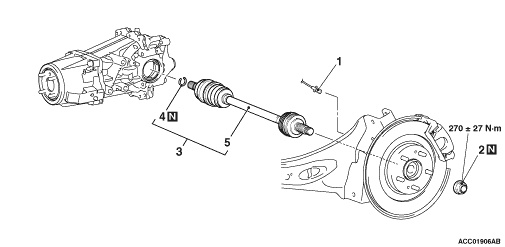Pre-removal operation
- Parking brake rear cable connection (Rear brake caliper side)
Removal and Installation (Refer to GROUP 36 -Parking Brakes
 ). ).
- Drain differential gear oil.
- Rear height sensor and control link disconnection (Refer to GROUP34 - Control
Link, Upper Arm and Lower Arm
 ). ).
- Disconnect joints between the lower arm, trailing arm, shock absorber, and stabilizer
link. (Refer to GROUP 34 - Control Link, Upper Arm, Lower Arm Removal and Installation
 ). ).
- Disconnect joint between the upper arm and the trailing arm. (Refer to GROUP 34- Control
Link, Upper Arm, Lower Arm Removal and Installation
 ). ).
|
Post-installation operation
- Connect the upper arm and the trailing arm. (Refer to GROUP
34 - Control Link, Upper Arm, Lower Arm Removal and Installation
 ). ).
- Connect the lower arm, trailing arm, shock absorber, and stabilizer link. (Refer
to GROUP 34 - Control Link, Upper Arm, Lower Arm Removal and Installation
 ). ).
- Fill the differential gear oil.
- Rear height sensor and control link connection (Refer to GROUP34 - Control
Link, Upper Arm and Lower Arm
 ). ).
- Wheel alignment check and adjustment (Refer to GROUP 34 - On-vehicle Service - Rear
Wheel Alignment Check and Adjustment
 ). ).
- Check the beam direction of the headlamp (Low beam) (Refer to GROUP 54A - Headlamp
Aiming
 ). ).
- Parking brake rear cable connection (Rear brake caliper side) Removal and Installation
(Refer to GROUP 36 -Parking Brakes
 ). ).
|

|
1.
| caution |
- Make sure that the lock
nut chisel is set in the correct direction. Otherwise, the groove or thread in the driveshaft
may be broken, or the tip of the chisel may be chipped.
- Never use a chisel which tip is damaged.
- For how to use the lock nut chisel, refer to the manufacturer’s operating
instructions.
|
Set the special tool lock nut chisel (MB992700) in the groove of the driveshaft with its
"UPPER" mark facing upwards. Then strike the staked portion of the driveshaft nut with the chisel
and a hammer to raise up.
|
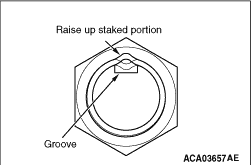
|
2.
| caution |
Be careful not to damage the thread of the driveshaft.
|
Raise up the staked portion of the driveshaft nut until it does not interfere with the
shaft thread.
|
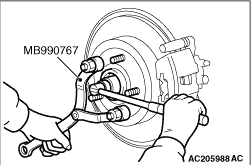
|
3.
| caution |
- Never use a impact wrench to loosen the
driveshaft nut.
- Do not apply the vehicle weight on the wheel bearing with the driveshaft nut loosened.
Otherwise, the wheel bearing may be broken.
|
Use special tool front hub and flange yoke holder (MB990767) to counter the hub, and remove
the driveshaft nut.
|

|
1.If the driveshaft is seized, use the following special tools to push the driveshaft out
from the hub:
- Puller shaft (MB990242)
- Puller bar (MB990244)
- Puller body (MB991354)
- Front hub and flange yoke holder (MB990767)
| caution |
- Do not pull out the driveshaft
from the EUJ assembly side. Otherwise, the ETJ assembly will be damaged. Be sure to remove the
driveshaft from the ETJ assembly side, by using a lever.
- Care must be taken to ensure that the oil seal of the differential carrier is not
damaged by the spline part of the driveshaft.
|
|

|
2.Use a lever to remove the driveshaft (ETJ assembly side) from the differential carrier.
|
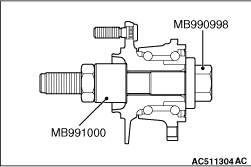
|
| caution |
Do not apply the vehicle weight to the wheel bearing with the driveshaft removed. If,
however, the vehicle weight shall be applied to the bearing (in order to move the vehicle),
use the following special tools for tightening to the specified torque (270 ± 27 N·m):
- Front hub remover and installer (MB990998)
- Spacer (MB991000)
|
|
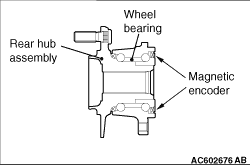
|
| caution |
- The wheel speed detection magnetic encoder collects metallic particles easily, because
it is magnetised. Make sure that the magnetic encoder should not collect metallic particles.
Check that there is not any trouble prior to reassembling it.
- When installing the drive shaft, make sure that it does not contact with the wheel
speed detection magnetic encoder (integrated with the inner oil seal) to avoid damage.
- Do not apply the vehicle weight on the rear wheel hub assembly before fully tightening
the driveshaft nuts. Otherwise, the wheel bearing will be broken.
|
1.Check the hub seated surface for damage or corrosion. Whenever solvent is used for
removing the corrosion, the surface should be degreased.
2.Check that the new driveshaft nut can be turned smoothly by hand. Then tighten it
until it is seated.
|
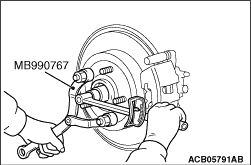
|
3.4.Using special tool front hub and flange yoke holder (MB990767), tighten the driveshaft
nut.
Tightening torque: 270 ± 27 N·m
5.After tightening to the specified torque, check that the nut is seated securely.
|
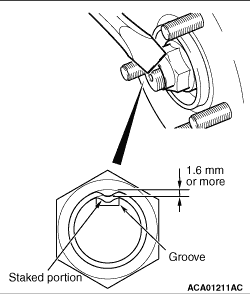
|
6.Use the chisel and a hammer to stake the nut until the centre in the staked portion reaches
the shown dimension.
7.Finally, check that the nut is not cracked at its staked portion.
|
 ).
). ).
). ).
). ).
). ).
). ).
). ).
). ).
). ).
). ).
).